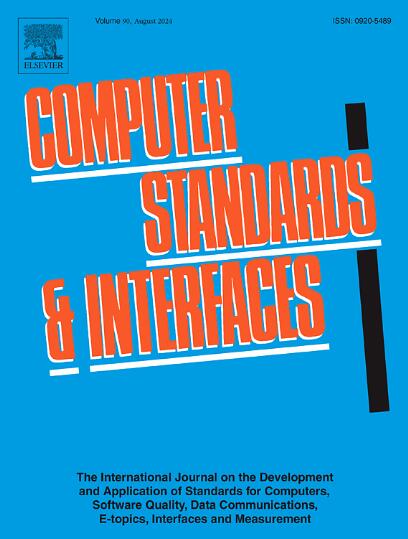SecureMD5:一种新的流密码,用于安全文件系统和人工智能加密密钥生成
IF 4.1
2区 计算机科学
Q1 COMPUTER SCIENCE, HARDWARE & ARCHITECTURE
引用次数: 0
摘要
企业员工或合作伙伴对敏感信息构成的内部威胁仍然是一个重大的网络安全挑战。在这方面,组织和公司为保护信息所采取的措施往往是不够的。主要是因为这些人拥有合法的访问权限和对安全漏洞的了解。本研究提出SecureMD5,一种专为安全文件系统(SFS)设计的加密算法。该算法基于集成到在字节级操作的加密方案中的自定义单向函数。它使用从上下文参数(如文件位置、访问时间、随机值和用户特定键)生成的11个动态变量。这种方法确保SecureMD5不会继承MD5作为标准加密算法的已知漏洞。因此,SecureMD5是一种自适应且强大的解决方案,可解决SFS内部威胁带来的挑战。同时,提出了一种模块化上下文密钥生成方案,该方案可以结合用户身份、访问时间和设备位置等各种挑战。基于人工智能(AI)方法的生物识别密钥生成的评估独立于加密算法的验证。在评估的生物识别密钥生成方案中,使用了OpenCV的人工智能模型MediaPipe Hand Landmark和LBPHFaceRecognizer。这些方法是基于上下文挑战的子键生成方案的一部分。该方案消除了对密钥存储的需求,以便对敏感信息进行动态和安全访问。通过扩散、混淆、熵和性能分析对SecureMD5进行验证。它的熵比同类算法高31%。性能比RC4提高了0.32%。它还通过了87%的NIST 800-22测试,证明了它对加密漏洞的稳健性。此外,SecureMD5平衡了安全性和性能,对于10mb文件,加密时间比修改后的AES算法快25%。使用精密度、准确度、错误接受率和特异性等指标对生物识别密钥生成方法进行评估,所有指标均达到80%以上的满意值。这项工作解决了信息安全方面的关键漏洞,在保护SFS免受内部威胁方面取得了重大进展。SecureMD5的设计和适应性使其特别适合具有严格安全要求的行业,例如医疗保健、金融和企业数据管理。它能够实现动态和安全的访问控制,解决了保护机密信息免受内部威胁所带来的真正挑战。本文章由计算机程序翻译,如有差异,请以英文原文为准。
SecureMD5: A new stream cipher for secure file systems and encryption key generation with artificial intelligence
The insider threat to sensitive information posed by employees or partners of an organisation remains a major cybersecurity challenge. In this regard, the measures taken by organisations and companies to protect information are often insufficient. Primarily, due to the legitimate access and knowledge of security holes that these individuals possess.
This study proposes SecureMD5, an encryption algorithm designed specifically for secure file systems (SFS). The algorithm is based on custom one-way functions integrated into an encryption scheme that operates at the byte level. It uses 11 dynamic variables generated from contextual parameters such as file position, access time, random values, and user-specific keys. This approach ensures that SecureMD5 does not inherit the known vulnerabilities of MD5 as a standard cryptographic algorithm. Consequently, SecureMD5 is presented as an adaptive and robust solution that addresses the challenges posed by insider threats in SFS.
In parallel, a modular contextual key generation scheme is proposed, which can incorporate various challenges such as user identity, access time and device location. Biometric key generation based on Artificial Intelligence (AI) methods is evaluated independently from the validation of the encryption algorithm. In the evaluated biometric key generation scheme, the AI models MediaPipe Hand Landmark and LBPHFaceRecognizer from OpenCV have been used. These methods are part of a sub-key generation scheme based on contextual challenges. This scheme eliminates the need for key storage for dynamic and secure access to sensitive information.
SecureMD5 was validated by diffusion, confusion, entropy and performance analysis. It achieved 31 % higher entropy than comparable algorithms. Performance improved by 0.32 % compared to RC4. It also passed 87 % of NIST 800–22 tests, demonstrating its robustness against cryptographic vulnerabilities. In addition, SecureMD5 balances security and performance, with encryption times 25 % faster than a modified AES algorithm for 10 MB files. Biometric key generation methods were evaluated using metrics such as precision, accuracy, false acceptance rate and specificity, achieving satisfactory values above 80 % on all metrics. This work addresses critical gaps in information security, providing significant advances in protecting SFS against insider threats. The design and adaptability of SecureMD5 make it particularly suitable for sectors with strict security requirements, such as healthcare, finance, and corporate data management. Its ability to enable dynamic and secure access control addresses the real challenges posed by protecting confidential information from internal threats.
求助全文
通过发布文献求助,成功后即可免费获取论文全文。
去求助
来源期刊

Computer Standards & Interfaces
工程技术-计算机:软件工程
CiteScore
11.90
自引率
16.00%
发文量
67
审稿时长
6 months
期刊介绍:
The quality of software, well-defined interfaces (hardware and software), the process of digitalisation, and accepted standards in these fields are essential for building and exploiting complex computing, communication, multimedia and measuring systems. Standards can simplify the design and construction of individual hardware and software components and help to ensure satisfactory interworking.
Computer Standards & Interfaces is an international journal dealing specifically with these topics.
The journal
• Provides information about activities and progress on the definition of computer standards, software quality, interfaces and methods, at national, European and international levels
• Publishes critical comments on standards and standards activities
• Disseminates user''s experiences and case studies in the application and exploitation of established or emerging standards, interfaces and methods
• Offers a forum for discussion on actual projects, standards, interfaces and methods by recognised experts
• Stimulates relevant research by providing a specialised refereed medium.
 求助内容:
求助内容: 应助结果提醒方式:
应助结果提醒方式:


